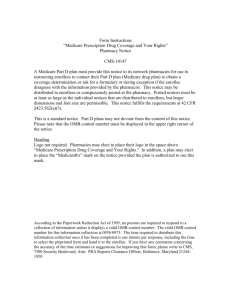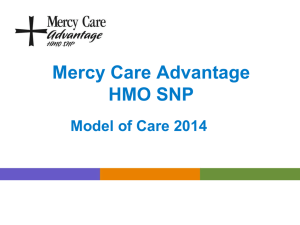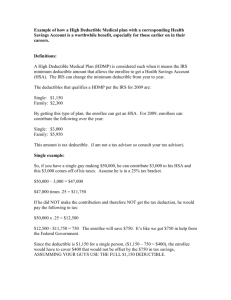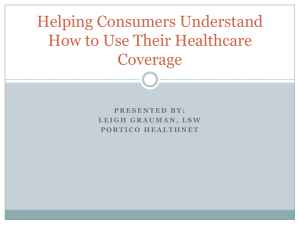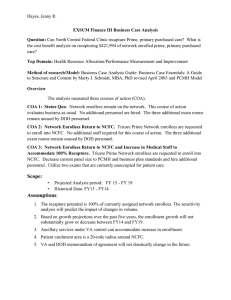How Sensitive are Low Income Families to Health Plan Prices? Please share
advertisement
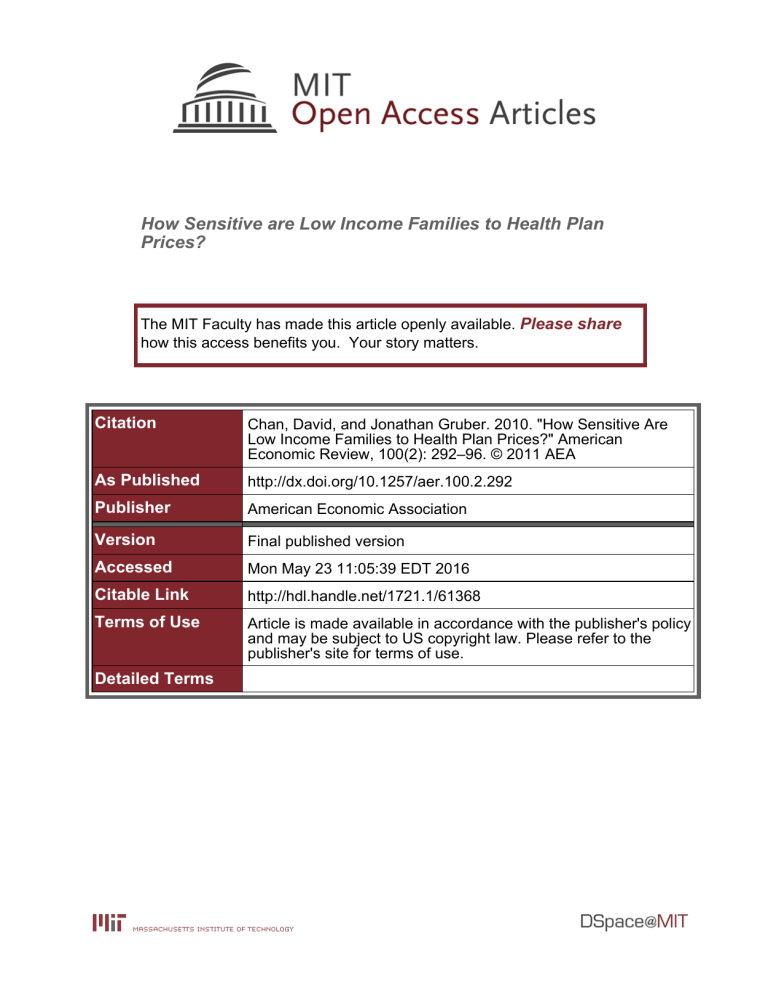
How Sensitive are Low Income Families to Health Plan Prices? The MIT Faculty has made this article openly available. Please share how this access benefits you. Your story matters. Citation Chan, David, and Jonathan Gruber. 2010. "How Sensitive Are Low Income Families to Health Plan Prices?" American Economic Review, 100(2): 292–96. © 2011 AEA As Published http://dx.doi.org/10.1257/aer.100.2.292 Publisher American Economic Association Version Final published version Accessed Mon May 23 11:05:39 EDT 2016 Citable Link http://hdl.handle.net/1721.1/61368 Terms of Use Article is made available in accordance with the publisher's policy and may be subject to US copyright law. Please refer to the publisher's site for terms of use. Detailed Terms American Economic Review: Papers & Proceedings 100 (May 2010): 292–296 http://www.aeaweb.org/articles.php?doi=10.1257/aer.100.2.292 The Massachusetts Health Insurance Experiment: Early Experiences † How Sensitive are Low Income Families to Health Plan Prices? By David Chan and Jonathan Gruber* Care Organizations (MMCOs) from which they could receive their coverage. Many enrollees were charged not only a base contribution rate, but the differential cost of their plan choice over the lowest-cost plan in their area. The financial implications of this decision were nontrivial; the average range in 2007 between the highest-cost plan and the lowest-cost plan across areas and income groups was $24.52 per month, and the maximum was $116 per month. Most relevantly for our study, there was a major shift in the pricing of plans for open enrollment in June 2008. At that open enrollment, the cost of the average plan increased by about $18.83, with a standard deviation of $30.22; in addition, the range in cost between the highest- and ­lowest-cost plan increased from 2007 to 2008. We have created a unique dataset using information from the state of Massachusetts on the enrollment decision of each Commonwealth Care recipient over the 2007–2008 period. We have data both on those enrollees who were already in a plan as of June 2007 and faced the decision over whether to switch plans (“prior enrollees”), and those who were newly choosing across plans through 2008 (“new enrollees”). For each enrollee we have information on income and an index of underlying medical-­ spending risk. We estimate a conditional logit model on these data, using the shift in pricing described above, to understand how price differentials impact plan choice. As health care reform moves forward in the United States, one common feature of virtually all proposals is to expand coverage for low income populations not through a traditional public insurance model, but rather through a “defined contribution exchange” mechanism. Under this approach, low income individuals would have a choice of a number of options for their insurance coverage. Individuals would receive a subsidy to purchase insurance that was tied to the lowest-cost plan (or some index of low-cost plans) and would pay some part of the difference if they chose a more expensive plan. This major departure from the traditional free/single-choice public payer model raises a number of important questions, but the key initial question is: How price-sensitive will lowincome consumers be in choosing across plans? While there is now a sizable literature evaluating plan choice in the context of employer-­provided insurance, there are no previous studies of how these very low income populations will respond to choice in publicly financed insurance programs. In this paper, we study the plan choice of low-income enrollees in Massachusetts’ Commonwealth Care program that was established as part of the state’s health reform in April 2006. Enrollees in Commonwealth Care were given a choice of up to four Medicaid Managed † Discussants: Jonathan Gruber, MIT Department of Economics; Joseph Newhouse, Harvard Kennedy School; Thomas Buchmueller, University of Michigan. I: Institutional Background on Commonwealth Care * Chan: MIT Department of Economics, 50 Memorial Drive, Cambridge, MA 02142–1347 (e-mail: d_c_chan@ mit.edu); Gruber: MIT Department of Economics and NBER, 50 Memorial Drive, Building E52, Room 355, Cambridge, MA 02142–1347 (e-mail: gruberj@mit.edu). Jonathan Gruber is a member of the Massachusetts Health Connector Board but this paper does not in any way reflect the positions of the Health Connector. The groundbreaking health care reform passed in Massachusetts in 2006 had a number of important features, including a mandate on individuals to purchase insurance and a reform of non-group and small group insurance 292 VOL. 100 NO. 2 How Sensitive are Low Income Families to Health Plan prices? ­ arkets. Most important for our purposes, the m law established the Commonwealth Care program for those in families with incomes below three times the poverty line (roughly $30,000 for singles and $60,000 for a family of four at the time of the law’s passage). Only individuals who were not eligible for other coverage (employer-sponsored insurance or Medicaid) could enroll. Starting in mid-2007, the first full year of the program, individuals were placed in one of six “plan types” depending on their income. Plan types were differentiated by the patient costsharing imposed in the plan and by enrollee contribution rates. Those below poverty were in plan type I; those who were 100–150 percent of poverty were in plan type IIA; and those who were 150–200 percent of poverty were in plan type IIB. For those 200-300 percent of poverty, there was in 2007 a choice of two different benefits structures, with plan type III having higher copayments and a lower premium cost to enrollees, and plan type IV having lower copayments and a higher premium cost to enrollees; within plan types III and IV there was a division into IIIA/B and IVA/B at 250 percent of poverty. Enrolling individuals had a choice of up to four Medicaid Managed Care Organizations (MMCOs); in some areas of the state the choice set was smaller due to limited regional coverage of some MMCOs. For example, by 2008, enrollees in Western Massachusetts generally had only two choices, while enrollees in Northern Massachusetts predominantly had four choices, and enrollees elsewhere, including Boston, had on average three choices. In 2007, individuals below 150 percent of the poverty line were enrolled in plan type I or plan type IIA free, and could enroll in any of the available MMCOs at no personal cost. Individuals in the remaining plan types had to pay a base contribution for the lowest-cost plan available in their area, as well as paying the full differential in the cost of choosing any plan that was above that lowest-cost plan. The base contribution was $35 for plan type IIB, $70 for plan type IIIA, and $105 for plan type IIIB. Enrollees choosing plan types IVA and IVB had the same base contributions as those in plan types IIIA and IIIB, respectively, since they were of the same income groups, but because they chose the lower copayment plans, premium contributions for all plans in IVA or IVB were above the base 293 contribution. Other than plan premiums, copayments within each plan type were standardized across MMCOs by the state.1 The system then changed in several important ways for open enrollment in June 2008. First, those in plan type IIA still could sign up for the lowest-cost option free but now had to pay the full differential for choosing a more expensive plan in their area. Second, plan types IVA and IVB, the more expensive plans with lower copayments for individuals at 200–300 percent of the federal poverty line, were discontinued. Once again, MMCOs made bids for each plan type and demographic group, understanding these structural changes in choice incentives. The result was a very significant shift in the cost of plan enrollment for those with incomes above the poverty line. These changes are illustrated in Table 1. This table shows, for each plan type, the mean and standard deviation of the change in contribution for the typical enrollee to stay in the same plan in 2008 as in 2007, as well as the mean and standard deviation of the change in contribution for the typical enrollee to move from the lowest- to highest-priced plan in the area. Enrollees in plan types IIA and IIB experienced an average increase in contributions of $9.14 and $14.04, respectively, while enrollees in plan types IIIA and IIIB experienced an increase in contributions of $48.66 and $50.85, respectively. While plan types IVA and IVB were discontinued in 2008, we present 2008 figures for increases in out-of-pocket costs assuming that enrollees would continue in the same MMCO in plan types IIIA and IIIB, respectively. Average contribution increases are $16.08 and $21.47 for enrollees originally in plan types IVA and IVB, because these plans were generally more expensive than plan types IIIA and IIIB, respectively, in 2007. In the next set of columns in the table, we show that the 1 In addition to enrollees who explicitly chose a plan, individuals below 150 percent of the poverty line who were deemed eligible but did not choose a plan were autoenrolled. The auto-enrollment algorithm could randomize auto-enrollees among several possible plans but was weighted towards low-cost plans. The MMCOs themselves made bids in early 2007 for the prices they would charge the state for each demographic group. Costs were calculated for each region based on the demographic composition of each region. Incentives to bid low came from both the assignment of auto-enrollees and the financial incentives for enrollees to choose low-cost plans. 294 MAY 2010 AEA PAPERS AND PROCEEDINGS Table 1—Changes in Enrollee Contribution by Plan Type Change in cost (in dollars) Cost range in 2007 (in dollars) Cost range in 2008 (in dollars) Plan type Mean SD Mean SD Mean SD IIA IIB IIIA IIIB IVA IVB Total 9.14 14.04 48.66 50.85 16.08 21.47 18.83 13.78 25.63 39.95 40.46 42.15 39.27 30.22 0.00 40.19 47.72 48.96 38.74 33.65 24.52 0.00 14.49 24.11 33.09 20.80 16.56 26.07 24.15 47.62 56.99 57.10 57.92 55.49 39.93 10.04 20.48 29.89 29.79 30.48 30.15 24.36 Notes: Numbers in the first set of columns represent the means and standard deviations of the change in enrollee contribution for each plan averaged across areas, plan type, and insurer. The next two sets of columns represent the difference in cost between the most expensive and cheapest plans for each area and plan type in 2007 and 2008. Enrollee contributions changed from “2007” to “2008” in July 2008. Plan types are as follows: IIA for those with incomes 100–150 percent of poverty, IIB for those 150–200 percent of poverty, IIIA or IVA for those 200–250 percent of poverty, and IIIB or IVB those 250–300 percent of poverty in plan type IIIB. Plan types IVA and IVB corresponded to lower-copayment, higher-premium options that were discontinued in 2008. To calculate the change in cost and 2008 cost range for IVA and IVB, we assume that enrollees continued in the corresponding plan by the same insurer and in the same area in IIIA and IIIB, respectively. difference between the highest- and lowestpriced choices that an enrollee faced generally increased from 2007 to 2008. Most notable are enrollees in plan type IIA, who faced no price differential in 2007 and then a $24.15 differential in 2008.2 II: Data and Results In order to assess the impact of this change in relative plan prices on plan choice, we have collected three sets of data with the helpful assistance of the staff of the Massachusetts Health Connector. The first set of data is information on all those who were enrolled in Commonwealth Care continuously from June 2007 to September 2008, a total of 75,184 “prior enrollees.” Table 2 of Chan and Gruber (2010) shows the distribution of enrollment across plan types and MMCOs; the greatest proportion of enrollment 2 We take area/plan prices as exogenous, which is problematic if there are omitted factors (e.g., brand preferences) which jointly determine the demand for, and pricing of, insurance plans. To the extent that such omitted factors are plan specific (e.g., preferences for or against a particular insurance company), we can control for them by including plan dummies in our regressions below, since there is differential pricing within plans by area and income group. If, however, there are differential preferences for particular plans by income or area, then this could bias our estimates. We attempt to address this concern below by including a summary statistic for brand preferences, the price that the plan charged in the prior period. is just above poverty, in plan type IIA. For each prior enrollee, we have data on demographic characteristics (age and sex), health care utilization, area of residence, original plan choice in 2007, and new plan choice in 2008. The second dataset contains information on all first-time enrollees during 2008, which includes a total of 115,010 “new enrollees,” of whom 52,307 are above poverty and therefore faced financial consequences in choosing a health plan. For each new enrollee, we have similar data as for old enrollees, with the exception of health utilization data and previous plan choices, since they are enrolling in Commonwealth Care for the first time. Finally, our third set of data is at the plan level, categorized by area, plan type, and MMCO. These data contain enrollee contributions for each plan choice available to them based on their income and area of residence. Using this information, we constructed conditional logit models to describe the discrete choice that prior and new enrollees faced. For prior enrollees, we first modeled the utility of a plan choice in 2008 as a function of whether the enrollee had chosen that plan previously in 2007 and the contribution price of the choice in 2008 during open enrollment for our base model: u old i, j = α1 Samei,j + α 2 P08, j + βPlanj + εi,j , VOL. 100 NO. 2 How Sensitive are Low Income Families to Health Plan prices? where i indicates the enrollee and j indicates the plan. Sameij is a dummy for whether prior enrollee i was enrolled in plan j in 2007; P08, j is the contribution price for plan j in 2008; Planj is a vector of plan dummies; and εij is an error term distributed independently and identically as extreme value. A. Conditional Logit Regression Results The first two columns in Table 2 present coefficients for regressions of prior enrollee choices. We find that both the enrollee price coefficient and whether the individual is choosing the same plan are highly significant. The relative magnitudes of the same-plan dummy coefficient and the price coefficient imply that a price difference of about $82 would be required for a prior enrollee to be equally likely to switch out of his prior plan, all else equal. The interpretation of the price coefficient is presented in the bottom rows of Table 2. We estimate that on average a $10 increase in the price of a plan lowers the probability that an individual chooses that plan by 8.3 percent in relative terms. This is a very large effect, but the $10 increase is also a very large change relative to baseline, especially considering that some enrollees pay nothing. As a result, the implied elasticity is −0.65. The second column in Table 2 shows results from a model which adds the contribution price from 2007, when the prior enrollee last chose a plan. We find that a significant positive coefficient on this previous-year price with a magnitude that is about 60 percent of with the negative coefficient on current-year price. The fact that lagged price is not zero suggests that price may be positively correlated with unobservable plan characteristics that may increase enrollee utility. Because copayments are the same across plans in each enrollee’s choice set, these characteristics may include the number of physicians or hospitals accepting a given plan. Moreover, these characteristics must represent area-specific plan differences, since we include non-interacted plan dummies in all regressions. At the same time, including this previous-year price has little impact on the coefficient on current period price, which implies that the price change is having an impact independent of plan preferences. Of course, we can’t rule out that plan preferences in a given income group/area 295 were changing along with prices, but that is a fairly weak identifying assumption. The third column in Table 2 presents regression results for new enrollees. The coefficient on price for this population is smaller, although we cannot directly compare effects to the prior enrollees since we do not have a control for prior plan choice. But the implied effect of a change in plan prices is larger: we find that a $10 increase in the price of a plan lowers the odds that the plan is chosen by a new enrollee by 15.4 percent, for an elasticity of −0.72. III. Summary A key parameter for evaluating the move towards choice-based models for low income populations is the degree of price sensitivity in these populations. We draw on the experience of the new low income insurance program in Massachusetts, which substantially and differentially changed its premiums in 2008, to assess this sensitivity. We find that both those who were already enrolled in the program, and those newly enrolling, are highly sensitive to price, with a $10 price change increase to a 8–16 percent expected relative reduction in the probability of choosing a given plan, and an implied elasticity of roughly −0.7. In Chan and Gruber (2010), we extend these models to consider heterogeneity in price responses. Among prior enrollees, those who are between 200 percent and 300 percent of the poverty line who chose plan type III in the previous year are about twice as price sensitive than those between 100 percent and 200 percent of the poverty line, with elasticities of plan choice around −2. At the same time, we find that the higher income individuals who chose the high premium/low copayment plan type IV in the previous year are not more price sensitive. That is, individuals who revealed themselves to care more about out of pocket costs and less about premiums in their 2007 choice are less price sensitive when choosing a plan in 2008. Likewise, when we divide our sample into those who chose the lowest cost plan in their area in 2007 and those who chose the highest cost plan in their area in 2007, we find much more price sensitivity in 2008 for the former group. We also examine the important question of whether price sensitivity varies by enrollee health status. We find that those prior ­enrollees 296 MAY 2010 AEA PAPERS AND PROCEEDINGS Table 2—Plan Choice Conditional Logit Regressions Independent variable Model Coefficients Same plan Same year price Previous year price (2007) Fallon NHP Network health Implied price responses Price elasticity Percent response to $10 price increase Prior enrollees (1) (2) 3.695* (0.071) −0.045* (0.002) −0.317* (0.128) 0.162 (0.127) −0.064 (0.096) 3.862* (0.074) −0.044* (0.002) 0.027* (0.006) −0.685* (0.149) −0.639* (0.163) −0.101 (0.092) −0.643 (1.032) −8.50 (7.70) −0.650 (1.052) −8.33 (8.07) New enrollees (3) −0.027* (0.002) −0.793* (0.223) −0.565* (0.178) −0.012 (0.199) −0.718 (0.656) −15.40 (2.54) Notes: Model coefficients with standard errors in parentheses are presented in the upper panel. In the lower panel, implied price responses averaged over the population are given with standard errors in parentheses for each model. Price responses represent elasticities and relative percentage change in probability given an own-price change and are weighted over the population and across choices by the likelihood of each enrollee to pick a choice. * Significant at the 5 percent level. who are less healthy are somewhat less price sensitive, but the differences are small. On the other hand, for new enrollees, we find large differences in price sensitivity by health status. This result suggests that to the extent that adverse selection operates in these new lowincome choice models, it is primarily at the point of program entry. These results suggest that defined contribution exchanges, in which consumers choose from a number of plans and bear some financial responsibility for their choices, may provide a strong incentive for insurance plans to lower costs in order to attract new enrollees, particularly for the near-poor in the 200–300 percent of poverty range. At the same time, the higher price sensitivity of the healthy in entering the program suggests that such price competition can engender adverse selection. Risk-adjustment would be appropriate to help mitigate such adverse selection in a choice-based model. REFERENCES Chan, David, and Jonathan Gruber. 2010. “Charging Low Income Families for Health Insurance: How Does it Impact Choices?” Unpublished.
